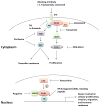PELP1: a review of PELP1 interactions, signaling, and biology
- PMID: 23933151
- PMCID: PMC3844065
- DOI: 10.1016/j.mce.2013.07.031
PELP1: a review of PELP1 interactions, signaling, and biology
Abstract
Proline, glutamic acid, and leucine rich protein 1 (PELP1) is a large multi-domain protein that has been shown to modulate an increasing number of pathways and biological processes. The first reports describing the cloning and characterization of PELP1 showed that it was an estrogen receptor coactivator. PELP1 has now been shown to be a coregulator for a growing number of transcription factors. Furthermore, recent reports have shown that PELP1 is a member of chromatin remodeling complexes. In addition to PELP1 nuclear functions, it has been shown to have cytoplasmic signaling functions as well. In the cytoplasm PELP1 acts as a scaffold molecule and mediates rapid signaling from growth factor and hormone receptors. PELP1 signaling ultimately plays a role in cancer biology by increasing proliferation and metastasis, among other cellular processes. Here we will review (1) the cloning and characterization of PELP1 expression, (2) interacting proteins, (3) PELP1 signaling, and (4) PELP1-mediated biology.
Keywords: AIB1; AR; BCAS3; CBP; CREB binding protein; ChIP; Coactivator; E2; ER; ERRα; Estrogen signaling; Extra-nuclear signaling; FHL2; GR; HDAC; Hormone resistance; IHC; ILK1; KDM1; LIM domain; Lin-1, Isl-1, and Mec-3 domain; MNAR; Modulator of Nongenomic Activity of ER; PELP1; RXR; SH2; SH3; STAT3; TIF2; amplified in breast cancer 1; androgen receptor; breast carcinoma amplified sequence 3; c-Src homology domain 2; c-Src homology domain 3; chromatin immunoprecipitation; estradiol; estrogen receptor; estrogen-related receptor alpha; four and a half LIM domains 2; glucocorticoid receptor; histone deacetylase; immunohistochemistry; integrin-linked kinase 1; lysine-specific histone demethylase 1; proline, glutamic acid and leucine rich protein 1; retinoid X receptor; signal transducer and activator or transcription 3; transcriptional mediators/intermediary factor 2.
Copyright © 2013 The Authors. Published by Elsevier Ireland Ltd.. All rights reserved.
Figures


Similar articles
-
Proline-, glutamic acid-, and leucine-rich protein-1/modulator of nongenomic activity of estrogen receptor enhances androgen receptor functions through LIM-only coactivator, four-and-a-half LIM-only protein 2.Mol Endocrinol. 2007 Mar;21(3):613-24. doi: 10.1210/me.2006-0269. Epub 2006 Dec 27. Mol Endocrinol. 2007. PMID: 17192406 Free PMC article.
-
Extranuclear functions of ER impact invasive migration and metastasis by breast cancer cells.Cancer Res. 2010 May 15;70(10):4092-101. doi: 10.1158/0008-5472.CAN-09-3834. Epub 2010 May 11. Cancer Res. 2010. PMID: 20460518 Free PMC article.
-
Functional and biological properties of the nuclear receptor coregulator PELP1/MNAR.Nucl Recept Signal. 2007 May 17;5:e004. doi: 10.1621/nrs.05004. Nucl Recept Signal. 2007. PMID: 17525794 Free PMC article. Review.
-
Cancer Stem Cell Phenotypes in ER+ Breast Cancer Models Are Promoted by PELP1/AIB1 Complexes.Mol Cancer Res. 2018 Apr;16(4):707-719. doi: 10.1158/1541-7786.MCR-17-0598. Epub 2018 Jan 18. Mol Cancer Res. 2018. PMID: 29348189 Free PMC article.
-
Emerging significance of ER-coregulator PELP1/MNAR in cancer.Histol Histopathol. 2007 Jan;22(1):91-6. doi: 10.14670/HH-22.91. Histol Histopathol. 2007. PMID: 17128415 Free PMC article. Review.
Cited by
-
PELP1 Is a Novel Therapeutic Target in Hepatocellular Carcinoma.Cancer Res Commun. 2024 Oct 1;4(10):2610-2620. doi: 10.1158/2767-9764.CRC-24-0173. Cancer Res Commun. 2024. PMID: 39258975 Free PMC article.
-
PELP1 inhibition by SMIP34 reduces endometrial cancer progression via attenuation of ribosomal biogenesis.Mol Oncol. 2024 Sep;18(9):2136-2156. doi: 10.1002/1878-0261.13539. Epub 2023 Nov 1. Mol Oncol. 2024. PMID: 37853941 Free PMC article.
-
Estrogen Receptor Signaling in Breast Cancer.Cancers (Basel). 2023 Sep 23;15(19):4689. doi: 10.3390/cancers15194689. Cancers (Basel). 2023. PMID: 37835383 Free PMC article. Review.
-
Targeting PELP1 oncogenic signaling in TNBC with the small molecule inhibitor SMIP34.Breast Cancer Res Treat. 2023 Jul;200(1):151-162. doi: 10.1007/s10549-023-06958-4. Epub 2023 May 18. Breast Cancer Res Treat. 2023. PMID: 37199805 Free PMC article.
-
Recent progress in targeted therapy for non-small cell lung cancer.Front Pharmacol. 2023 Feb 21;14:1125547. doi: 10.3389/fphar.2023.1125547. eCollection 2023. Front Pharmacol. 2023. PMID: 36909198 Free PMC article. Review.
References
-
- Barletta F, Wong CW, McNally C, Komm BS, Katzenellenbogen B, Cheskis BJ. Characterization of the interactions of estrogen receptor and MNAR in the activation of cSrc. Mol Endocrinol. 2004;18:1096–1108. - PubMed
-
- Beguelin W, Diaz Flaque MC, Proietti CJ, Cayrol F, Rivas MA, Tkach M, Rosemblit C, Tocci JM, Charreau EH, Schillaci R, Elizalde PV. Progesterone receptor induces ErbB-2 nuclear translocation to promote breast cancer growth via a novel transcriptional effect: ErbB-2 function as a coactivator of Stat3. Mol Cell Biol. 2010;30:5456–5472. - PMC - PubMed
-
- Beyer C. Estrogen and the developing mammalian brain. Anatomy and embryology. 1999;199:379–390. - PubMed
Publication types
MeSH terms
Substances
Grants and funding
LinkOut - more resources
Full Text Sources
Other Literature Sources
Research Materials
Miscellaneous


